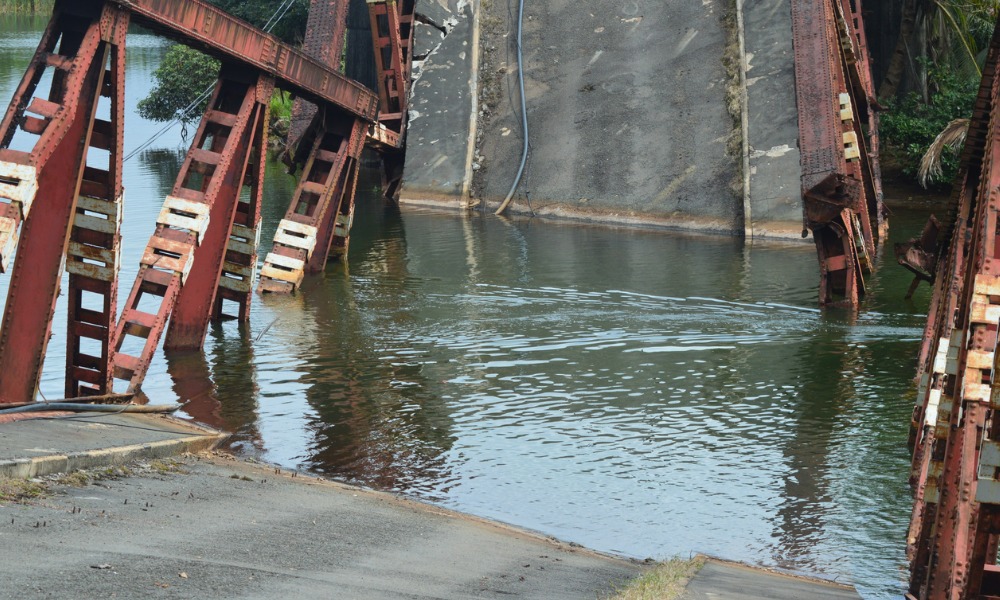Employer fined $175,000 plus surcharge

Ontario employer R.M. Belanger Limited was fined $175,000 plus a 25-per-cent surcharge after pleading guilty to a violation that resulted in the death of one worker.
The charge stems from an Aug. 14, 2019, incident, when a crew of eight Belanger employees were at the site of a bridge that was assembled on the road on the east side of the creek, then pushed across the creek on rollers and set down on concrete landing pads.
The 120-foot long temporary modular bridge was to be assembled and installed to carry road traffic to accommodate the replacement of the existing culvert.
The bridge was moved across the creek and was set down on pillars of 6” x 6” wood cribbing at each corner. ‘Bottle jacks’ were to be used to jack the bridge down in stages, removing cribbing as it was lowered. Seven of the eight crew were engaged in this operation. A supervisor was directing the workers in the lowering of the bridge.
One of the workers on the crew was not involved in moving or jacking the bridge but was involved on the site as a driver, and bringing other workers tools and water as needed.
Lowering the bridge was to be accomplished by using two bottle jacks on each corner. One jack would take the weight of the bridge while cribbing was removed from one side of each cribbing tower. A second jack would then take the weight while the first jack was removed and cribbing taken from the other side of the tower. The bridge would thus be lowered one step at a time by releasing pressure with a valve on the bottle jack.
The lowering of the bridge was being coordinated by the supervisor. At each lowering stage, the bridge was fully supported by a bottle jack on each corner. The supervisor was using only a level on one end of the bridge in giving instructions to workers on all corners regarding the rate of movement of each corner. No mechanical means was being used to coordinate the rate of movement as between the various jacks.
At one point in the process, it was observed that a jack at the northwest corner was starting to lean. The supervisor went to that corner to observe the jack. While the supervisor turned to return to the work station, that jack tipped over, allowing the 18-ton bridge to collapse. It tipped from the jacks at three of the corners.
The worker who was not involved in moving or jacking was sitting on the concrete landing pad and was crushed by the frame of the bridge, suffering fatal injuries. Another worker suffered non-critical injuries as the bridge fell and moved to the side.
The worker who died had about 15 minutes earlier been sitting on a pile of discarded cribbing but had been asked to move.
An investigation by the Ministry of Labour, Training, and Skills Development could not determine the exact cause of the bridge collapse. However, a number of factors were found to have contributed to the collapse and the resulting fatality:
- Section 213(1) of the Construction Projects Regulation (Regulation 213/91) prohibits a worker who is not directly involved in the movement of a structure from being near it. The deceased worker was not involved in the jacking of the bridge.
- The manufacturers’ operating manuals for the bottle jacks being used all caution against workers being under an object being supported by the jack. In addition to the deceased worker, who was sitting under the frame of the bridge when it collapsed, all of those involved in jacking the bridge were at times under the structure to utilize the jacks.
- The manufacturer of the temporary modular bridge cautioned against both ends of the bridge being jacked at the same time. Its operating manual requires that one end always be secured against accidental movement when the other end is being supported on jacks. At the time of the bridge collapse, both ends of the bridge were supported only by bottle jacks.
- A geotechnical engineering report obtained in advance of movement of the bridge, as required by the MTO contract, approved of the location of bridge support bearing pads at specified locations where the composition and contours of the soil could support them.The cribbing towers, however, were erected on ground that had not been analyzed in the engineering process and was adjacent to sloped ground.
- Coordination of the jacking process was controlled by the supervisor. A mechanical means of coordination – for example, a central hydraulic line going to both sides of each end of the bridge – would have allowed even, coordinated and level movement of the structure without reliance on an individual’s perception and direction to multiple workers as to the pace of jack movement at each location.
- Approval was obtained from the MTO for the installation of the bridge based on submitted engineering documents. The approved process required excavation of the launching side of the creek for assembly of the bridge modules so that when the bridge was pushed across the creek, it would only need to be jacked down about 13-1/2 inches. However, the bridge was assembled at road grade, so that when it was in place over the concrete support pads, it was on cribbing towers over 1.4 metres high, requiring considerably more jacking stages over a much greater distance.
- The maximum distance each end should be jacked at any time, according to the bridge manufacturer’s operating manual, was 75 mm (about 3 inches). Investigation demonstrated that the distance of the bridge frame from the cribbing at the time of the collapse was 12 inches (about 300 mm), as illustrated by the distance at the one corner of the bridge that did not fall from its jack. No method had been used to minimize the gap between the bridge structure and the cribbing towers during each jacking phase.
The company pleaded guilty of failing as an employer to take every precaution reasonable in the circumstances for the protection of a worker, contrary to section 25(2)(h) of the Occupational Health and Safety Act.
On Feb. 26, 2021, the company was convicted under the same violation of the OHSA and fined $210,000 when a worker was killed at a golf course near Sudbury. That worker was struck by a wooden telephone pole while it was being loaded with a forklift onto a trailer.
Previously, Ontario-based DSI Underground Canada Ltd. was fined $70,000 after one of its workers was injured from being hit by a cable. Also, Saskatchewan company B L S Asphalt Inc. was fined a total of $350,000 after being found guilty of two violations under The Occupational Health and Safety Regulations, 1996.





